

This investigation addresses certain dimensions of international university cooperation, specifically international consortia in higher education. Although reasons vary as to why they were developed in the first place, the majority of international consortia began positioning themselves after World War II and with much increased intensity since then. International consortia, regardless of their mission or purpose, have arguably supplemented higher educational institutions as invisible colleges,1 whereby the physical infrastructure of institutions has given way to the cooperative relationships established in order to provide adequate quality and variety of instruction, to keep in touch with worldwide trends, and to further promote the dissemination and advancement of knowledge. This study investigates the emergence of 600 + international university organisations worldwide, with particular survey data directed toward international consortia. If the various forms of international cooperation in higher education can be determined to be outcomes of globalisation, internationalisation, and other spheres of influence, the analysis of such organisations may contribute to a deeper understanding of these forces.
The contemporary interplay between globalisation and internationalisation in higher education creates many complex perspectives and viewpoints, which in turn, generate varying degrees of influence. Definitions aside, the often interchangeable usage of these terms suggests a relativistic borderlessness of abstraction. The terms are indeed complex but distinctive---they can be applied as processes and as outcomes---and the variety of ways they can be defined add to the difficulty in arriving at an all-encompassing, working definition for both, particularly within the specific domain of higher education. The nominalisation2 of globalisation and internationalisation has ‘nounified’ these terms, representing a be-all-to-end-all for articulating the abstract nature of whatever context they appear to influence. Yet cultural variations of the terms3 need further examination, not only because globalisation and internationalisation are perceived differently on the receiving ends as opposed to the giving ends, but because the actions, reactions, and responses are dictated by the cultural make-up, values, and virtues of a given, involved society. The institutionalisation of a standardised world-system, which, in and of itself may be construed as a form of cultural imperialism, cannot work without voluntary participation of and by the majority.
Current literature pertaining to globalisation indicates influential factors of an integrated world economy---however loosely that may be defined---which help determine the forecasting of a world-system from world labour to knowledge distribution. Yet, globalisation is increasingly illustrated in a wider degree of applications and disciplines. According to Sklair, Bretherton and Ponton, globalisation should more or less be viewed as a discourse. Sklair identifies his four resource clusters in relation to the research interests of scholars, namely:
Bretherton and Ponton, alternatively, view the symptomatic effects of globalisation in the following four elements:
The compartmentalising of globalisation into strands makes it increasingly cross-disciplinary in focus, emphasising the fact that globalisation is as much a way of thinking as it is a science, however qualitative may be its focus. Wittgenstein’s mythical ‘world-picture’,4 which serves as a basis, a foundation (Grundlage), or a point of departure of a community’s looking at the world (Kober, 1996; 419), provides a useful example. According to Wittgenstein, the more one immerses oneself in other cultures and languages around the world, the greater one’s imagination, and hence, the greater one’s world view.
A re-investigation of Gestalt Theory also has prompted many scholars to apply it to disciplines outside of its traditional application in psychology5 . The original research in 1923 by Max Wertheimer led to a non-empirical approach to thinking and problem solving. As his son recounts,
A problem exists when something is not clear, does not fit together, has a gap; this disturbance produces a striving to resolve the lack of clarity, and the solution results in everything fitting together and making sense (Michael Wertheimer, 1979; 134).
If one were to juxtapose this hypothesis with that of globalisation, then one could accept the Gestaltian proposition that: 1) globalisation cannot be measured by placing a quantitative value on it, because of its context-dependent and culture-specific nature; 2) globalisation as a ‘collective whole’ incorporates the inter-connected web of relationships that configure its composite which gives it meaning and potentiality; and 3) globalisation cannot be adequately studied or solved at the nation-state level. (Sklair, 1994; Sklair 1998). Globalisation requires, and therefore is, a new way of thinking. Within the specific context of comparative and international education, globalisation may infer an infusion of ideas, people, and resources with the aim of disseminating and advancing knowledge in, around, and throughout the world-at-large. In other words, the globalisation of higher education suggests an ideological sense of collective consciousness and action, with the underlying pursuit of cooperation on a worldwide scale to foster, promote, and advocate veritas ( truth).
Universalism and particularism may also correlate global issues with that of related ideologies such as: economic rationalism (global capitalism); activism (global pacifism); and altruism (global altruism). First is a universalism of standardisation, systemisation, unification, integration, and harmonisation, all of which tend to indirectly or directly force the world---or specified region or locality---to view itself as a collective whole. The second approach is based on a particularism of expounding one’s understanding and awareness of the world---a self-serving notion limited to the capacity of one’s imagination, and as such, fiercely independent of any outside control. Particularism may also be perceived as another form of fragmentation whereby individual rights compete against consensus. This does not necessarily imply that this form is polar opposite to ad hoc policy; it merely points to a widening, paradoxical gap between those advocating globalisation (convergence) and others advocating fragmentation (divergence). Both tendencies are equal in force, but cannot be measured in the same way. In essence, the converging aspects of globalisation fosters an overarching umbrella of actions and reactions that promote a systemisation, standardisation, and other forms of uniformity on a worldwide scale. This conformity is the basis for future advancement (civilisation-building). However, divergent aspects are equally as strong, and as a result, ‘imagined communities’, utilising Anderson’s concept, emerge and take place. The objective of these conflicting---sometimes paradoxical notions---is the hopeful pursuit of greater knowledge through collaboration. Unfortunately, the intrinsic characteristics of human agency and the competing nature of capitalism (whatever the form), gives economic rationalism and protectionism an edge over the noble aspirations of any form of international cooperation. The current train of thought promotes the notion that in order to compete, one has to cooperate. However, even such a noble idea with good intentions has its consequences.
Both universalism and particularism are a revitalisation of the traditional theological concepts of universalism and particularism to accentuate---and perhaps even promote---a way of thinking. Unlike Gestalt, this new way of thinking tends to signal some form of manipulation, whether direct or indirect, to fashion a way of thinking that benefits a given group, from neo-liberals who advocate a universality of free trade and worldwide economic interdependence to special interest groups who advocate the need to mobilise the world to address issues of common concern (e.g. Greenpeace). Both have their critics, and some contend that globalisation perceived in this light may dismiss---even shun---the needs of individual communities, the needs of which may differ from the rest, thus creating increased conflicts of interest. This view of globalisation has led to further division between global capitalists, egalitarians, pacifists and altruists, suggesting polarity between advocates of universalism and advocates of particularism. This may not necessarily be the case. Instead, globalisation may be inter-linked between universalism and particularism in a duality that shares outward and inward seeking tendencies. The outward seeking tendency tends to embrace an idealistic hope of increased international awareness, of increased altruistic virtues and pursuits, and the collective will to ameliorate global ills that plague the planet. The inward seeking tendency is ego-centric and based on greed, power, and survival; in other words, it represents the fundamental nature of the human condition. As a result, inward seeking globalisation tends to promote exclusiveness, elitism and class structure, furthering a ‘club mentality’.
Internationalisation is commonly viewed as the relationship-building process between two nations or more which are bound by a common purpose. The first recorded usage of the term international was in Jeremy Bentham’s Principles of Morals and Legislation, published in 1780. The term was formed from English inter- + national, originally replacing the sense ‘of nations’ in the ‘law of nations’ (The Barnhart Dictionary of Etymology, 1988). The emphasis on process is what differentiates between international6 and internationalisation in the contemporary context, and because of its characteristic two-way or multi-national interaction, it can be interpreted differently, depending on discipline and culture. In higher education, however, internationalisation can also reflect the self-serving notion of becoming more internationally aware, more internationally-focused, and more internationally-recognised. Many higher educational mission statements, as a case in point, are strategically designed to promote and enhance their internationalisation efforts by encouraging international student and faculty exchange, internationalising curricula, conducting international research, and, whenever possible, streamlining procedures by consolidating and sharing resources and staff. Internationalisation, on an institutional level, may thus be construed as an outward-seeking, self-fulfilling initiative with incentive-based and competition-induced tendencies. It may also have little, if any, hint of two-way or multi-national interaction unless the type of cooperation serves a tangible purpose. International cooperation may be viewed as a spin-off of the internationalisation process, but it is not perceived as the over-riding goal or mission of the institution or institutions involved.
If internationalisation is viewed as a relation-building process intended to work with other international bodies to achieve a common goal or set of goals, then the combined teamwork, mutual respect, and potential for growth, enrichment, and progress may boost---even accelerate---globalisation processes. Internationalisation, in this instance, is but one means to ideologically achieve a globalised end---in essence to achieve globalisation as an end product---an outcome---as well as serving as its conduit. Thus, this cooperative perspective on internationalisation may be viewed as a catalyst for the perpetual supply of pluses, bonuses, sight-unseen spin-offs as by-products of globalisation. Negative outcomes tend to be traced back to the ideological origins of globalisation and/or fragmentation.
Internationalisation may also be seen as the pragmatic response to the ideology behind globalisation. Many international university organisations actively engaged in internationalisation processes are project-type organisations, in which each international activity is project-managed. In this instance, this competitive orientation regarding internationalisation is not so much of a relation-building process but as a codifying one. Although tacit knowledge is valued, the pragmatic codification of international activities detaches the projects from the individual, and thus, shifts the focus from personal interaction to a business transaction. Regardless of how internationalisation is perceived, it is often the spheres of influence which are the most instrumental in promoting or negating internationalisation efforts.
The identification of current spheres of influence is important in ascertaining the causal link between the precipitous movement towards increased international activity by globalisation advocates and the reactions to it by its recipients (whether voluntary or reluctant). In the process, the analysis of influential factors offers a starting point for greater objectivity in understanding the rationales and justifications for such developments and their ramifications. Within the context of international university cooperation, sponsorship, marketability, degree recognition, and visibility tend to be the primary motivating forces that drive globalisation advocates to internationalise, while development, quality assurance, consolidation of resources, and sharing of costs tend to be the primary factors for globalisation recipients. The underlying difference, despite the obvious tension between international competition and cooperation, is the perpetual shift in the stratification of consumer-based and knowledge-based social class structures. In other words, the ‘haves’ and ‘have nots’ and the ‘know’ and ‘know nots’ have helped maintain and solidify a worldwide status-quo. The various spheres of influence affecting internationalisation are numerous and, as they evolve over time, they become increasingly complex. They have grown to incorporate not only the governmental sectors (international, national, and regional), but also the private and educational7 (Knight and deWit, 1995; Knight 1997).
In sum, the delineation of meaning and context between globalisation and internationalisation demonstrates an often indiscernible tension between international cooperation as an idealistic hope and international competition as an economic rationalistic reality. If globalisation of higher education is perceived as a process of convergence, embracing not only the economic aspects of a globally integrated economy but also the systemisation of world knowledge (dissemination and pursuit thereof), then internationalisation may be perceived as its conduit. This complementary interaction between both processes helps facilitate, maintain, and monitor the spheres of influence from global to local levels and vice versa. However, this is not its only role. Internationalisation, as a process of divergence within the convergence of globalisation, may also paradoxically go against all sense of economic rationalism, simply to embrace, respect or challenge the values, beliefs, and customs of a unique, but international culture. This suggests that the internationalisation process can sway to and fro, overlapping with globalisation processes, with regional processes of fragmentation, and in certain instances, with both. The outcome may produce patterns similar to those of globalisation, which result in increased confusion between terms, but the evolving nature of internationalisation is not necessarily dependent on globalisation. Just because a culture may not necessarily assimilate into mainstream thought (i.e. the ideology of globalisation), does not imply that it is any less international. Circumstances are often quite the contrary, indicating conflicting---sometimes hidden---agendas.
In an era of exponential change in the inter-connectedness across the world, the proliferation of international organisations is pronounced. The roles these organisations play in the global arena are what this study attempts to address. Do such organisations have more to do with the sustainability of their activities than with an all-inclusive, global imperative of cooperation? Does globalisation promote greater academic freedom in the form of social mobility, the dissemination and advancement of knowledge, and the autonomy of Lern- and Lehrfreiheit in any given discipline? Or does globalisation pose certain constraints in the systematisation of international cooperative organisations---and thus, internationalisation processes---with only the successful ones reaping the benefits of such controlled interactions? It is suggested that if the commodification of education---specifically international education---were to continue, then international cooperation is crucial if not vital in maintaining a competitive edge. This is based on the overarching belief that globalisation has more to do with economics than with political or socio-cultural influences. It is assumed that by increasing their market share, institutions can expand on programs and initiatives while consolidating costs. However, the financial demands are often high and risky.
As mentioned previously, international consortia in higher education began positioning themselves after World War II and with increasing intensity from the mid 1980s to present day. Among those international consortia which participated in the study, the distribution of founding dates is as follows:
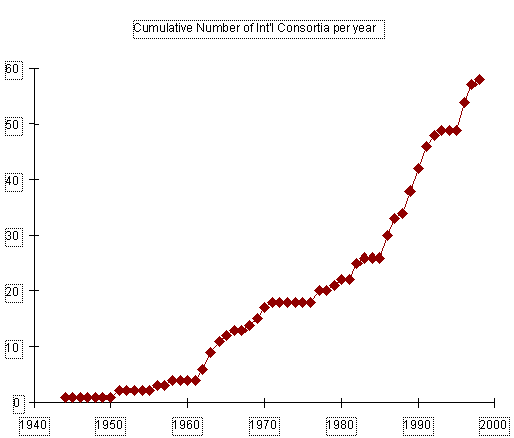
The data indicate increased activity in the formation of international consortia, particularly between 1986 and 1992. 1972-1977, 1983-1985, 1993-1994 are periods when there were no new establishments. Despite these periods, however, which may be related to market downturns, increased security issues, or other factors, it appears that international consortia are proliferating. Considering the present majority, the economic incentives to be reaped by individual member institutions have arguably taken precedence over the good-will nature of the cooperative inter-institutional relationships. Although institutions may legitimise their collective involvement for furthering international cooperation---particularly in the name of internationalisation in individualised mission statements---it is the economic gains, the consolidation of costs, staff, and resources, and international recognition and visibility that determine the extent of their active participation. To a lesser extent, there are visionary leaders who see beyond the financial benefits, and although they may actively seek mutually exclusive, working relationships for purposes of a common---usually international---cause, they are under increasing financial accountability. In some cases, they are using whatever means necessary just to keep their aim or mission alive, sometimes at great risk. Ownership, or more precisely stakeholdership, thus becomes paramount in terms of invested interest from the visionary leader, from the corpus of its members, and from other stakeholders who are financially accountable. International consortia, then, in their pure, ideological form, require an equilibrium and validation of stakeholdership, a sharing of strategic and tactical responsibilities, and perhaps most importantly, joint outcome accountability.
Spheres of influence have direct and indirect impacts on the internationalisation process, and hence, on the development of international consortia. ‘Stakeholder’ agendas determine courses of action and, although conceptual and empirical constructs may attempt to infer causal relationships between processes (globalisation and internationalisation) and outcomes (international university cooperation), the vast array of worldwide educational systems, contexts, and culture-specific issues make it difficult to confirm any hierarchical or scaffolding effect in organisational structure. Hegemonic struggles for power and autonomy, freedom of access, and the unequal basis on which individuals, groups, and nations participate in, and make, history may compound---even distort---the pursuit towards greater international cooperation. For those stakeholders who do volunteer to assemble as members of international university organisations, particularly international consortia, the unique qualities inherent in such participatory interactions indicate non-linear trends, even though their involvement tends to be based on practical rather than ideological considerations. As A.H. Robertson states,
International organisations are not created by starry-eyed idealists in order to give effect to their dreams; they are set up by realistic governments (notoriously reluctant to spend money without good cause) in order to meet practical needs (A.H. Robertson, 1966; 1).
Not all international organisations, which can be divided into international, national, and regional sectors, are initiated by governments. They may also be developed by private and educational sectors as well, resulting in a growing diversity of types of international consortia.
International consortia are voluntary, participatory organisations of at least three higher educational institutions with a primary mission of disseminating and advancing knowledge on an international level. This dissemination and advancement of knowledge may include two or more of the following: collaborative projects and programs that are international in scope; faculty and student exchanges; curriculum-sharing; resource sharing; developmental assistance; and faculty training. Moreover, international consortia must possess the following administrative characteristics: a governing body; a manager; a mission; an active commitment by member institutions; and a funding source that serve to support, expand, diversify and, perhaps more precisely, supplement inter-institutional cooperation on an international level. Although there are other types of international university organisations which mirror the structure and function of international consortia, each claim to have their own unique purpose, mission, or niche market.
In the study conducted on international consortia in higher education, a total of 635 international university organisations were identified, of which 103 were excluded because they failed to meet the defined criteria for inclusion, provided insufficient information, or could not be reached through four separate mailings. Of the 532 remaining in the study, 180 international university organisations responded with a total response rate of 33.8%.
The following analysis of the data compiled illustrate the distinctiveness between international consortia, international alliances, and international agencies in terms of purpose:


Distinctions can also be found in how these organisations formed. As a case in point, organisations which initially formed from individual faculty initiatives are more likely to be institution sponsored and administered. Others which formed as a result of international, intra-regional, or national policies are more likely to be government sponsored and institution or agency administered. Finally, those which are independent of higher educational institutions and government are most likely to be both agency sponsored and administered, and hence more entrepreneurial in focus.
The following data in Figure 1.3 reflect differences between international consortia, international alliances, and international agencies in terms of sponsorship and administration:
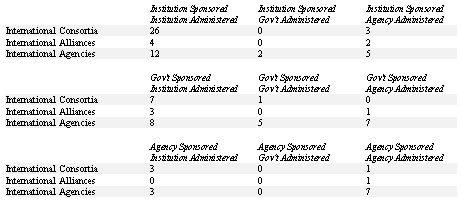
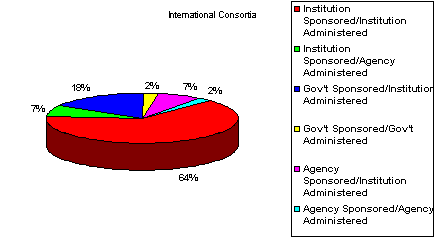
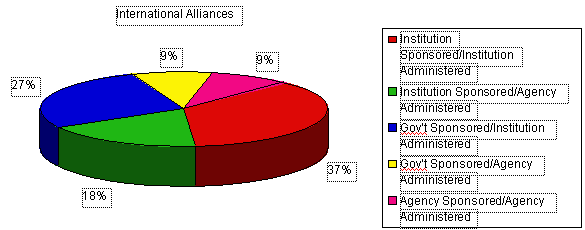
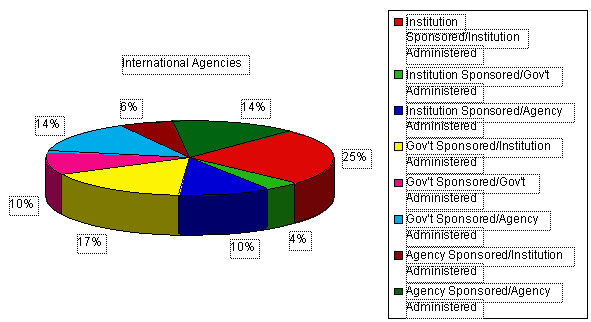
The predominance of international consortia as institution sponsored and administered (f=26) suggests that the majority are governed and managed by higher educational institutions and individual faculty members. International alliances and agencies, on the other hand, can be viewed as consisting of two types: international alliances likely to be institution sponsored and administered much like that of international consortia or embody a government sponsored and institution administered characteristic similar to that of some international agencies; and international agencies that are principally government sponsored and institution or agency administered. They may also profile certain types of organisations that are both agency sponsored and administered.
The organisational identity of institution sponsored and administered organisations clearly suggests the utility of a bottom-top approach, suggesting that their formation does not necessarily relate to the direct institutionalisation of inter-regional, intra-regional, or national spheres of influence. Government sponsored international alliances and agencies are more affected by the institutionalisation of public policy, and because of the implications of a top-bottom approach, such organisations are more prone to conflicting agendas and market forces. Agency sponsored international agencies, on the other hand, are more likely to develop as a result of a bottom-top approach, suggesting that they are highly influenced by leadership, a strategic vision, and market demand.
The over-all examination of data concerning sponsorship and administration suggest that international consortia are predominantly initiated at the institutional level. The majority of international alliances and agencies tend to be more influenced by international, intra-regional and national policies. A small proportion of international agencies are in a separate category that suggests a market-driven, self-supporting type focus. The manner in which these organisations have been formed can be defined in terms of bottom-top and top-bottom approaches. These approaches can be described as having the following characteristics:
Despite the difference in approaches, all contribute to the development of international university cooperation. Davies and Guppy concur that such types of cooperation are taking greater hold in either the top bottom or the bottom top approach. They state,
As a result, we argue that globalization’s effect on education is a simultaneous centralization and devolution of authority that squeezes power from middle levels of educational administration and redistributes it upward to more central states and downward to individual schools and reform groups (Davies and Guppy, 1997; 438).
The formation of international consortia in higher education has brought with it a number of new challenges for administrative services, academic staff support, and in the sharing of resources and expertise. The following data in Figure 1.4 indicate the distributions of sharing resources among international consortia, international alliances, and international agencies:
Table 3 Figure 1.4: Sharing Resources (3 graphs)

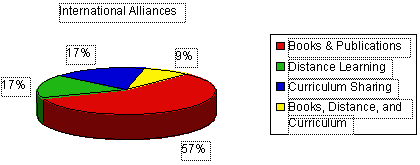
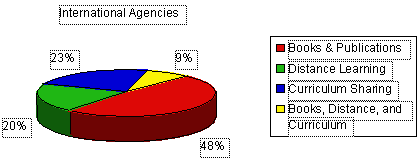
The sharing of resources suggests that the transference of infrastructure and competencies are advantageous to inter-institutional partnerships in the long run, which may also develop into new and innovative ‘spin off’ opportunities elsewhere which would otherwise not be tapped. It may also offer altruistic dividends in the short term, but the sharing of resources continues to be more one-way than two-way, and it is usually the partner institutions from the developed world which need to foster and cultivate such development. The great majority of international university organisations worldwide come from the developed countries of the United States, France, Belgium, United Kingdom, and Canada respectively.
Indeed, the development of international consortia brings new challenges to higher education. These include but are not limited to such issues as: pools of new, non-traditional students and staff (international); course transferability and recognition of degrees; work ethos and protocol across diverse cultures; compliance and standardisation of course content; intellectual property rights; and attempts to seek new and diversified funding opportunities. International consortia have had to structure themselves to meet these challenges. Most, if not all, have been required to establish successful governing and managerial structures not only to ensure quality control and accountability, but to convince their sponsoring members of their leadership, efficiency, and effectiveness. Due in part to streamlining procedures and consolidating staff and resources, they often lack the bureaucratic mazes that impede progress---a typical concern of foundations, corporations, and individual sponsors on universities themselves---and as such have increasingly lured institutional, corporate, foundation, and government support for their programs and initiatives. The following data in Figure 1.5 reflect differences between international consortia, international alliances, and international agencies in terms of funding sources:
Table 4 Figure 1.5: Funding Sources (3 graphs)

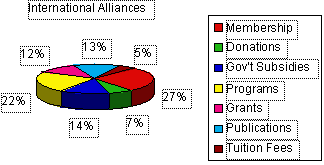
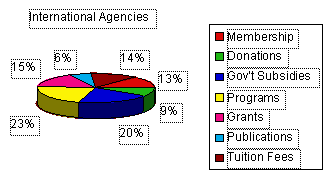
| International Consortia: | 21% grants, 19% membership dues, 19% tuition fees, 15% gov’t subsidies, 13% programs and activities, 10% donations, 3% publications. Funding sources tend to be evenly distributed between the top three |
| International Alliances: | 27% membership dues, 22% programs and activities, 14% government subsidies, and 13% publications, 12% grants, 7% donations, 5% tuition fees. Heavy reliance on membership dues and participation |
| International Agencies: | 23% programs and activities, 20% government subsidies, 15% grants, 14% tuition fees, 13% membership dues, 9% donations, 6% publications. Type 1 is heavily financed by means of government subsidies and grant opportunities. Type 2 is market-driven and keeps financially afloat by means of programs and activities and tuition fees |
This paper has attempted to determine whether globalisation, internationalisation, and other spheres of influence have direct and indirect relationships on the formation of international consortia. It is clear they do, yet it has also been determined that there is no uniform sense of measurement. External factors such as these are in and of themselves non-linear, ebbing and flowing from various stakeholder agendas competing and vying for control from convergent and divergent perspectives. The ideological hope for fostering international cooperation also buckles under the increasing stress of economic pressures based on realistic need. This may suggest that globalisation is contingent on capitalism, but if globalisation may be perceived as a way of thinking (a discourse), it may exist with or without capitalism. In other words, globalisation is not necessarily dependent on capitalism. Internationalisation, on the other hand, may be construed as an outward-seeking, self-fulfilling initiative with incentive-based and competition-induced tendencies. It may also have little, if any, hint of two way or multi-national interaction unless the type of cooperation serves a tangible purpose. International cooperation may be viewed as a spin-off of the internationalisation process, but it is not perceived as the over-riding goal or mission of the institution or institutions involved.
Empirical evidence suggests that international consortia have formed solely on the basis of economic need or financial incentives since World War II. Given the dominance of international university organisations within the developed world, it will become increasingly necessary for these organisations to offset the knowledge divide between the ‘know’ and ‘know nots’ by sharing competencies and infrastructure with partner institutions in the developing world. This last figures reflect the challenges ahead for international consortia in higher education:
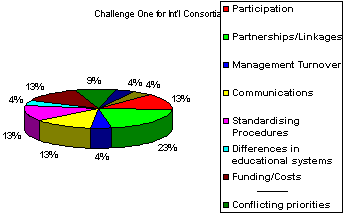
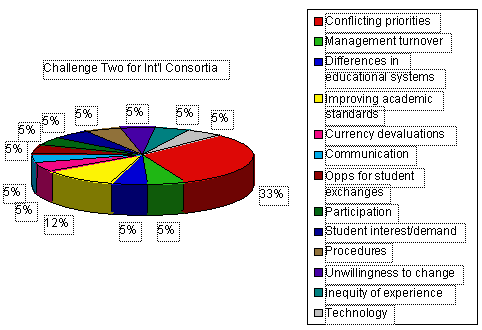
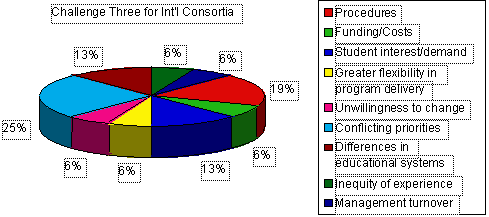
The greatest challenges international consortia have identified for themselves are: ‘maintaining partnerships and linkages (23%); ‘fostering active participation of members’ (13%); ‘dealing with language and cultural barriers regarding communication’ (13%); ‘standardising programs and procedures’ (13%); and ‘recognizing the reality of lack of funds and high costs’ (13%). Secondary challenges include: ‘conflicting priorities’ (33%), and ‘improving academic standards and compliance’ (12%).
It is this evidence that suggests that international consortia are rising up to the challenge of fostering, promoting, and sustaining international cooperation in higher education. Those universities which take on the task of becoming more internationally aware, more internationally-focused, and more internationally-recognised will increasingly find that the inter-institutional relationships cultivated over time will ensure the pivotal role higher education has in the distribution and advancement of knowledge in the world. Through these partnerships, it can only be hoped that knowledge will become a fundamental right for all, that the pursuit and advancement of knowledge be shared, and that the knowledge be used constructively to ameliorate ills that plague the world as a whole.
Altbach, Phillip G., (1998). Comparative Higher Education: Knowledge, the University, and Development. Ablex Publishing Corporation, Greenwich, Connecticut.
Anderson, Benedict (1991). Imagined Communities: Reflections on the Origin and Spread of Nationalism. Revised edition. Verso Publications, London.
Astin, Alexander W. and Calvin B.T. Lee (1972). The Invisible Colleges: A Profile of Small, Private Colleges with Limited Resources. The Carnegie Foundation for the Advancement of Teaching. McGraw-Hill Book Company, New York.
Bazerman, Charles (1998). “Emerging Perspectives on the Many Dimensions of Scientific Discourse”. In: Reading Science: Critical and Functional Perspectives on Discourses of Science. J.R. Martin and Robert Veel, eds. Routledge, London (pp. 15-28).
Bretherton, Charlotte and Geoffrey Ponton, eds. (1996). Global Politics: An Introduction. Blackwell Publishers, Oxford, United Kingdom.
Crane, Diana (1972). Invisible Colleges: Diffusion of Knowledge in Scientific Communities. The University of Chicago Press, Chicago.
Davies, Scott & Neil Guppy (1997). “Globalization and Educational Reforms in Anglo-American Democracies”. In: Comparative Education Review, vol 41, no 4. (November 1997) Comparative and International Education Society, pp. 435-459.
Duderstadt, James J., (2000). “A Choice of Transformation for the 21st-Century University”. In: The Chronicle of Higher Education, vol XLVI, no 22 (February 4, 2000), pp. B6-B7.
Halliday, M.A.K., (1994). An Introduction to Functional Grammar, 2nd Edition. Edward Arnold, London, United Kingdom.
Knight, Jane & Hans de Wit (1995). “Strategies for Internationalisation of Higher Education: Historical and Conceptual Perspectives”. In: Strategies for Internationalisation of Higher Education. Hans de Wit, ed. European Association for International Education, Amsterdam, The Netherlands, pp. 5-32.
Knight, Jane (1997). “Internationalisation of Higher Education: A Conceptual Framework” In: Internationalisation of Higher Education in Asia Pacific Countries. Jane Knight and Hans de Wit, eds. EAIE, Amsterdam, The Netherlands, pp. 5-19.
Kober, Michael (1996). “Certainties of a World-Picture: The epistemological investigations of On Certainty”. In: The Cambridge Companion to Wittgenstein. Hans Sluga and David G. Stern, eds. Cambridge University Press, Cambridge, United Kingdom, pp. 411-441.
Robertson, A.H., (1966). European Institutions: Cooperation, Integration, Unification. Second Edition, The London Institute of World Affairs, Frederick A Praeger, Publishers, New York, USA.
Sklair, Leslie (1998). “Competing Conceptions of Globalization”. In: Contemporary Sociology. Steve Taylor, ed. MacMillan Press.
The Barnhart Dictionary of Etymology (1988). Robert K Barnhart, ed. The HW Wilson Company.
Wertheimer, Michael (1979). A Brief History of Psychology. Revised Edition. Holt, Rinehart and Winston, New York, USA.
1. Usage of the term ‘invisible colleges’ was first used by Diana Crane, in her 1972 publication, Invisible Colleges: Diffusion of Knowledge in Scientific Communities. She defined invisible colleges as networks that were created among groups of academic albeit scientific collaborators. In the same year, Astin and Lee’s Invisible Colleges referred to the lesser known higher educational institutions in the United States, which, in their obscurity were less concerned about their status, and therefore standards, within the greater higher education community.
2. Halliday initially defined the term nominalisation as “...the single most powerful resource for creating grammatical metaphor” (Halliday, 1994; 352). Bazerman further illustrates that “...nominalisation has served to create higher and higher order abstractions which provide conceptual objects that populate the intellectual landscape of scientific specialities” (Bazerman, 1998, 19).
3. The spellings of globalisation and internationalisation alone provide a useful example of how Anglophone variations of globalisation may be superseded by the American spelling. The digitalisation of literary works is standardising the way the word is spelled, particularly since internet search engines, databases, and CD ROMs generally recognise only correct spellings. For those countries which do not have the resources or infrastructure to digitalise their scholarly pursuits, they run the risk of being completely overlooked, since it is often assumed that all countries are involved in the globalisation process.
4. A world-picture is a view of things particular to a location, held by a particular group of individuals at a certain period of time (Kober, 1996; 419). Wittgenstein’s understanding of world-picture as mythology may be interpreted to mean the views and convictions of a cultural community.
5. One of many misconceptions of Gestalt Theory is that it is restricted to only psychological applications. This is not true. Wertheimer applied Gestalt to truth, ethics, and democracy in the same vein as globalisation is applied in contemporary terms.
6. What does it mean to be international in contemporary terms? As Altbach states, “Academic institutions are international. They are linked across international boundaries by a common historical tradition. They are connected by an international knowledge network that communicates research worldwide through books, journals, and, increasingly, databases. Scholars are part of an ‘invisible college’ that constitutes disciplines and specialities” (Altbach, 1998; 147). But to what extent can an institution of higher learning label itself as international if it only serves a local population? This is where internationalisation comes into the picture. The level of meeting certain internationalisation goals is limited only to the capabilities of the institution. This, in essence, defines what is ‘international’ in contemporary terms.
7. Both Knight and de Wit prefer to use the term ‘stakeholders’ to refer to those sectors that play an active role in the development of internationalisation policy and practice. In this study, spheres of influence may refer to stakeholders, who claim a sense of ownership in the internationalisation process(es), but they may also incorporate all other influential factors which occur haphazardly or with no known purpose or mission. Particularly in times of uncertainty, stakeholdership and ownership become votes of no confidence when devaluation, unmet expectations, and disinvestment occur.
Copyright remains exclusively with the author.